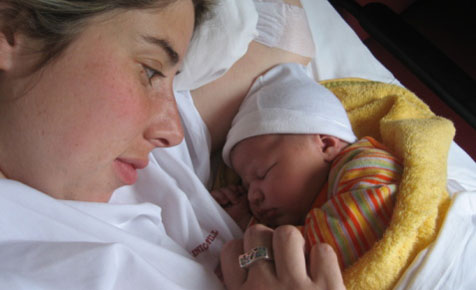Whether you will ‘need’ an episiotomy will very much depend on the way your individual caregiver practises and their beliefs about when an episiotomy would be necessary. There are now quite a few research studies that show a correlation between different caregivers and the place a woman gives birth and whether she will end up with an episiotomy or not.
In general midwives will perform episiotomies less often than doctors, but midwives who work in delivery suites are much more likely to perform them than midwives who work in birth centres or in home birth practices. Midwives in these settings generally reserve them for cases of fetal distress. Be aware that individual caregiver practices can vary even within the one birth place setting.
The following are the past beliefs and the research findings about episiotomies.
Belief:
An episiotomy protects the muscles of the pelvic floor from perineal tears during vaginal birth. It prevents 3rd and 4th degree tears.
The research: –
Episiotomy cuts through the pelvic floor muscles and at best will cause an equivalent injury to a 2nd degree tear. It is now known that the majority of 3rd and 4th degree tears are more likely to occur from an episiotomy being performed either through the caregiver over-cutting or the cut extending into a tear through to the anus. An episiotomy extending can be likened to snipping the edge of a sheet of cloth, weakening the fabric and making it easier to tear.
Belief:
An episiotomy prevents the pelvic floor from over-stretching, which in turn prevents urinary or bowel incontinence, prolapse of the vagina or uterus and loss of sexual sensation.
The research: –
When an episiotomy is performed the pelvic floor muscles are already at full stretch. Cutting into them will not prevent this. There is no evidence to support the fact that episiotomy protects against any of above health problems.
These have more to do with the pelvic muscle strength that is developed through performing many pelvic floor exercises in pregnancy and after the birth.
In the case of bowel incontinence, because an episiotomy increases the chances of a 3rd or 4th degree tear, performing one can actually contribute to increasing the chances of this happening.
Belief:
An episiotomy is needed for a forceps delivery.
The research: –
It is now known that performing a forceps delivery without an episiotomy reduces the incidence of deep, severe perineal tears. Not having one can increase the chances of the woman sustaining shallow vaginal wall tears, but these usually do not need stitching and normally heal well, causing no long term complications.
Belief:
An episiotomy is needed for a ventouse delivery.
The research: –
A ventouse birth is similar in principal to an unassisted vaginal birth and should not require a routine episiotomy.
Belief:
An episiotomy is easier to repair because it is a clean cut rather than a ragged tear.
The research: –
While it seems strange to think that any competent caregiver working in childbirth would not be able to repair both, it is also common that a tear is generally as straightforward to repair as an episiotomy. Also if an episiotomy is capable of doing more harm than good it should not be the sole reason to perform one.
Belief:
An episiotomy will shorten the 2nd stage of labour.
The research: –
An episiotomy can shorten the 2nd stage of the labour by about 3 to 5 contractions or about 15 to 20 minutes. This can be a valid reason for performing one if the baby’s head is well down on the perineum and they are showing signs of distress with a prolonged low heart rate. The episiotomy can help the baby to be born more rapidly.
If the mother is exhausted known as maternal exhaustion, an episiotomy is debatable, as they are only really effective for delivering the baby quickly when they are very close to being born anyway.
In this case, if the mother is reluctant to push, then an episiotomy may be an option (or a ventouse or forceps lift out).
Belief:
An episiotomy prevents cerebral haemorrhage, mental retardation and trauma to a premature baby’s skull.
The research: –
The perineum is a soft flexible muscle. There is no evidence to support any of these proposed advantages for premature babies.
Belief:
An episiotomy is needed for internal manipulations for shoulder dystocia.
The research: –
There is no research that proves that an episiotomy is actually beneficial in this case, but as it is regarded as an emergency situation, many caregivers feel one should be done. In reality it is the bones of the woman’s pelvis holding the baby back, not the woman’s perineum.
Belief:
The woman is too physically fit (for example she is a dancer or rides horses) and therefore her perineum will be unable to relax and stretch effectively.
The research: –
Women with strong pelvic floor muscles are more likely to end up with an intact perineum and have fewer problems with urinary incontinence after the birth.
Belief:
‘She has fair skin’, ‘she is Asian’, ‘she has a short perineum’, or ‘it is her first baby’ therefore she will need an episiotomy.
The research: –
There is no support for any of these perceptions and they are not valid reasons for performing an episiotomy. It is true that first time mothers are more likely to receive them than women having subsequent babies.
Belief:
The perineum is button-holing or starting to tear in the middle of the perineum, instead of from the vaginal edge.
The reality: –
As the baby’s head emerges, the perineum will normally tear from the buttonhole upwards toward the edge of the vagina. This is better than extending downwards towards the anus, as may be the case with an episiotomy.
Belief:
Injecting the perineum with local anaesthetic just in case an episiotomy is needed numbs the perineum.
The reality: –
Injecting local anaesthetic into the perineum swells the perineal tissues and increases the chances of the perineum tearing. The ‘just in case’ theory, rarely means the episiotomy will not be done and invariably gives the caregiver a reason to perform one.
Belief:
The perineum is looking white or blanched and ‘looks like’ it will tear.
The reality: –
It is the author’s experience that the perineum can often look ‘blanched or white’ as it stretches to full capacity, but still end up not tearing if given the chance.
While some caregivers feel they have to watch the perineum this is not absolutely necessary. It is well known that certain positions which ‘hide’ the perineum such as squatting, standing, sitting on a birth stool or the toilet or being in the bath are protective from having an episiotomy done.







Leave A Comment
You must be logged in to post a comment.